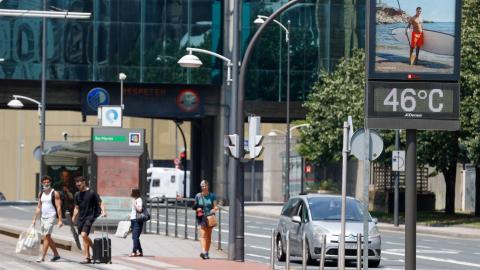Most sites in North America that will host the 2026 World Cup are at high risk of extreme heat
Ten of the 16 stadiums that will host the 2026 FIFA Men's World Cup in Mexico, the United States and Canada are at ‘very high’ risk of extreme heat stress conditions, according to a study published in Scientific Reports. Using data from the Copernicus Climate Change Service, the analysis concludes that the risk will be highest at stadiums in Arlington, Houston (USA) and Monterrey (Mexico).

Julien Périard . calor mundial FIFA EN
Julien Périard
Deputy Director, University of Canberra Research Institute for Sport and Exercise (Australia)
The study modelled the risk of severe heat stress and the potential for water losses to exacerbate this stress in professional football players, as well the impact of low oxygen content at altitude at different stadia in Canada, the US and Mexico, for the upcoming 2026 FIFA World Cup. The authors identified that 10 out of 16 playing sites of the 2026 World Cup were at a very high risk of experiencing extreme heat stress conditions.
The study is a positive step forward in moving beyond the wet-bulb-globe temperature (WBGT) index to determine if environmental heat stress increases the risk of exertional heat illness in football players. By using the Universal Thermal Climate Index (UTCI) adjusted for exercise, the authors considered not only the environmental conditions, but the activity level of the players (the metabolic heat they produce), their movement speed (the potential for heat loss through airflow), as well as their clothing (a potential barrier for heat loss). In contrast, the WBGT only uses environmental conditions (ambient temperature, humidity and solar heat load) to determine the severity of an environment, neglecting to account for sport and player specific characteristics.
Although the approach used in the study is a step forward, the results likely underestimate the risk of experiencing extreme heat stress conditions. This is due to the highest work rate that can be integrated into the UTCI being 285 W/m2, which as the authors acknowledged, is roughly half, if not less, than the work rate sustained by professional players during a competitive football match. For the estimation of water losses via sweating, a work rate of 450 W/m2 was used, which is closer, albeit still lower, to what the players would sustain. Notwithstanding, this approach predicted that sweat losses exceeding 1.5 kg/h would occur primarily in 3 stadiums (Arlington, Monterrey and Houston). However, sweat losses greater than 1.5 kg/h are likely to occur in other locations with higher work rates being maintained, especially if environmental conditions are more severe than predicted in the model.
Ultimately, the outcomes of the study may help tournament organisers to optimise the scheduling of match times, but FIFA is required to take action regarding their current policy of using a WBGT of 32ºC to implement cooling and hydration breaks during matches. We have recently shown the efficacy of the FIFA hydration and cooling breaks in male players during a simulated match. We have also called for the development of a football-specific heat stress policy with actionable categories (e.g. cooling break, cooling break with extended half-time and cooling, postponement/cancellation) that account for the evaporative heat loss requirement of players and the evaporative capacity of the environment, based on the prevailing ambient conditions and player activity and clothing. Such a policy could be implemented at the 2026 World cup, as well as the 2030 World Cup in Spain, Portugal and Morocco to protect the health of players and the integrity of the game.
Conflict of interest: "No conflicts of interest to declare, other than receiving funding from FIFA to conduct the project linked".
Katarzyna Lindner-Cendrowska et al.
- Research article
- Peer reviewed



